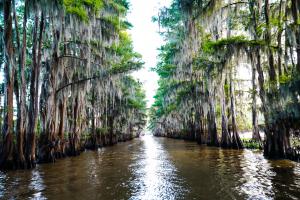
Louisiana Swamps Play Crucial Role in Water Filtration and Flood Mitigation, Says Local Tour Operator
Milton Walker Jr., owner of Louisiana Tour Company in Marrero, Louisiana, underscores the importance of raising awareness about the ecological services provided by swamps, particularly as urban development continues to encroach on natural landscapes.
“Swamps are more than scenic backdrops,” said Walker. “They work every day to clean water, reduce runoff, and absorb floodwaters. Understanding these functions is key to appreciating what is lost when wetlands are destroyed.”
Louisiana's swamps are characterized by slow-moving or standing water, cypress and tupelo trees, and a network of organic soils and vegetation. This environment creates a natural filtration system. As water flows into swamp areas—whether from rain, rivers, or runoff—it slows down, allowing suspended sediments to settle. Plant roots, decaying organic matter, and microbial activity then work to absorb excess nutrients, heavy metals, and contaminants from the water.
Nutrient overload, particularly nitrogen and phosphorus from agricultural runoff, can lead to harmful algal blooms and oxygen-deprived waters in lakes and coastal areas. Swamps capture and process these nutrients before they reach open water, effectively reducing the likelihood of downstream pollution. The process is slow, continuous, and self-sustaining, with plant matter cycling nutrients back into the soil.
In addition to filtering water, swamps provide critical flood control. Their sponge-like soils absorb large volumes of rainwater and surface runoff during storms. This retention delays the movement of water into rivers and urban drainage systems, reducing peak flood heights and easing pressure on levees and pumping stations.
This buffering capacity is particularly important during tropical storms and hurricanes. As storm surges push inland, swamps serve as natural shock absorbers, dispersing wave energy and reducing erosion. Even a few inches of elevation loss in wetland areas can significantly increase flood risk in nearby communities.
Vegetation in swamps contributes to these effects. Trees and shrubs slow down the movement of water, increase infiltration, and stabilize soils. In contrast, areas stripped of vegetation are prone to erosion, channelization, and rapid water flow—conditions that increase both flood risk and water quality degradation.
The role of swamps in carbon sequestration also intersects with their water functions. As plants grow and die in wet environments, they accumulate as peat and organic matter, locking away carbon. This same organic-rich soil structure improves water retention and filtration. When wetlands are drained or filled, that stored carbon is released into the atmosphere, and the water-regulating capacity is lost.
Despite their value, Louisiana's swamps have been disappearing at a rapid pace. Coastal erosion, levee construction, canal dredging, and subsidence have contributed to the loss of thousands of acres of wetland each year. The continued development of flood-prone areas has further strained remaining swamp systems, reducing their effectiveness as natural infrastructure.
Public understanding of swamp ecology remains limited. Interpretive tours and education programs offer one avenue for connecting residents and visitors with the importance of wetland preservation. Seeing firsthand how these ecosystems function fosters a deeper appreciation for their unseen work—particularly in a region where water management is a daily concern.
Restoration efforts are underway in several areas across South Louisiana. Projects focus on reconnecting rivers to their floodplains, reintroducing native vegetation, and allowing natural sediment deposition to rebuild lost wetland areas. While these projects face technical and financial challenges, their long-term value lies in the services they restore—water filtration, flood reduction, habitat creation, and climate resilience.
From an ecological perspective, the functionality of swamps lies in their complexity. Water, soil, vegetation, and wildlife interact in layered cycles, maintaining balance without the need for mechanical systems. Unlike traditional infrastructure, which requires maintenance and eventual replacement, swamps self-renew through seasonal cycles and ecological feedback loops.
Preserving and restoring swamp systems is not only a matter of environmental stewardship but also a practical solution to the challenges of stormwater management, drinking water protection, and flood control. Every acre of swamp preserved adds to a region’s natural capacity to manage water—without pumps, pipes, or concrete.
As communities continue to grow, the value of these systems becomes more visible during periods of stress—heavy rainfall, rising seas, and stronger storms. Understanding and supporting the role of swamps in water management is a step toward smarter land use, stronger communities, and healthier ecosystems.
Morgan Thomas
Rhino Digital, LLC
+1 504-875-5036
email us here
Visit us on social media:
Facebook
Distribution channels: Agriculture, Farming & Forestry Industry, Culture, Society & Lifestyle, Environment, Travel & Tourism Industry
Legal Disclaimer:
EIN Presswire provides this news content "as is" without warranty of any kind. We do not accept any responsibility or liability for the accuracy, content, images, videos, licenses, completeness, legality, or reliability of the information contained in this article. If you have any complaints or copyright issues related to this article, kindly contact the author above.
Submit your press release

